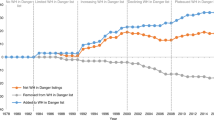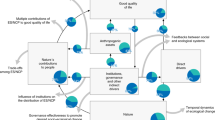Abstract
Despite decades of international efforts to enhance global environmental governance, sustainability issues requiring action beyond single states persist. How can we create international environmental governance systems (typically called regimes) that are successful in addressing problems such as climate change and the loss of biological diversity? What skills do we need to design regimes that are responsive to these challenges? Reflecting on years of research on environmental regimes, this Perspective identifies promising research strategies for continuing efforts to answer these questions (for example, diagnostic procedures and alternative ideas on effectiveness) in a manner that promotes productive relations between academics and practitioners.
This is a preview of subscription content, access via your institution
Access options
Access Nature and 54 other Nature Portfolio journals
Get Nature+, our best-value online-access subscription
$29.99 / 30 days
cancel any time
Subscribe to this journal
Receive 12 digital issues and online access to articles
$119.00 per year
only $9.92 per issue
Buy this article
- Purchase on Springer Link
- Instant access to full article PDF
Prices may be subject to local taxes which are calculated during checkout

Similar content being viewed by others
References
Vitousek, P. et al. Human domination of the Earthas ecosystems. Science 277, 494–499 (1997).
Steffen, W. et al. Global Change and the Earth System: a Planet under Pressure (Springer, Heidelberg, 2004).
Galaz, V. Global Environmental Governance. Technology and Politics: The Anthropocene Gap (Edward Elgar, Cheltenham, 2014).
Mitchell, R. B. International Environmental Regimes Database (accessed 15 June 2018); http://iea.uoregon.edu
Parson, E. A. Protecting the Ozone Layer: Science and Strategy (Oxford Univ. Press, New York, 2003).
Cherry, T., Hovi, J. & McEvoy, D. Toward a New Climate Agreement: Conflict Resolution and Governance (Routledge, London, 2016).
Chayes, A. & Chayes, A. H. The New Sovereignty: Compliance with International Regulatory Agreements (Harvard Univ. Press, Cambridge, 1995).
Raustiala, K. & Slaughter, A. M. in Handbook of International Relations (eds Carlsnaes et al.) 538–558 (Sage Publications, London, 2002).
Zaelke, D. et al. Making Law Work: Environmental Compliance and Sustainable Development (Cameron May, London, 2005).
Strange, S. in International Regimes (ed. Krasner, S. D.) 337–354 (Cornell Univ. Press, Ithaca, 1983).
Mearsheimer, J. The false promise of international institutions. Int. Secur. 19, 5–49 (1994–1995).
Rosenau, J. N. & Czempiel, E.-O. Governance without Government: Order and Change in World Politics (Cambridge Univ. Press, Cambridge, 1992).
Haas, P., Keohane, R. & Levy, M. Institutions for the Earth: Sources of Effective International Environmental Protection (MIT Press, Cambridge, 1993).
Kanie, N., Andresen, S. & Haas, P. M. Improving Global Environmental Governance: Best Practices for Architecture and Agency (Routledge, New York, 2014).
Mitchell, R. B. in Institutions and Environmental Change (eds Young, O. R. et al.) 79–114 (MIT Press, Cambridge, 2008).
Underdal, A. in Institutions and Environmental Change (eds Young, O. R. et al.) 49–78 (MIT Press, Cambridge, 2008).
Young, O. R. The effectiveness of international environmental regimes: existing knowledge, cutting-edge themes, and research strategies. Proc. Natl Acad. Sci. USA 108, 19853–19860 (2011).
Keohane, R. O. After Hegemony: Cooperation and Discord in the World Political Economy (Princeton Univ. Press, Princeton, 1984).
Ruggie, J. G. in International Regimes (ed. Krasner, S. D.) 195–231 (Cornell Univ. Press, Ithaca, 1983).
Miles, E. L. et al. Environmental Regime Effectiveness: Confronting Theory with Evidence (MIT Press, Cambridge, 2002).
Mitchell, R. B. A quantitative approach to evaluating international environmental regimes. Glob. Env. Polit. 2, 58–83 (2002).
Breitmeier, H., Young, O. R. & Zürn, M. Analyzing International Environmental Regimes: From Case Study to Database (MIT Press, Cambridge, 2006).
Breitmeier, H., Underdal, A. & Young, O. R. in Politik und Umwelt (eds Jacob, K. et al.) 41–59 (VS-Verlag, Wiesbaden, 2011).
Keohane, R. O. Neorealism and its Critics (Columbia Univ. Press, New York, 2006).
Schelling, T. C. Micromotives and Macrobehavior (W. W. Norton, New York, 1978).
Ostrom, E. et al. The Drama of the Commons (National Academies Press, Washington DC, 2002).
Young, O. R. The Effectiveness of International Environmental Agreements: Causal Connections and Behavioral Mechanisms (MIT Press, Cambridge, 1999).
Stokke, O. S. Disaggregating International Regimes: A New Approach to Evaluation and Comparison (MIT Press, Cambridge, 2012).
Lyster, S. International Wildlife Law (Grotius, Cambridge, 1995).
Brennan, D. Arms Control, Disarmament and National Security (George Braziller, New York, 1961).
Young, O. R. Governing Complex Systems: Social Capital for the Anthropocene. (MIT Press, Cambridge, 2017).
Galaz, V. et al. in Institutions and Environmental Change (eds Young, O. R. et al.) 147–188 (MIT Press, Cambridge, 2008).
Young, O. R. The Institutional Dimensions of Environmental Change: Fit. Interplay, and Scale (MIT Press,Cambridge, 2002).
Cox, M. Advancing the diagnostic analysis of environmental problems. Int. J. Comm. 5, 346–363 (2011).
Ostrom, E. A diagnostic approach to going beyond panaceas. Proc. Natl Acad. Sci. USA 104, 15181–15187 (2007).
Ostrom, E. & Cox, M. Moving beyond panaceas: a multi-tiered diagnostic approach for social-ecological analysis. Env. Conserv. 37, 451–463 (2010).
Mitchell, R. B. International Oil Pollution at Sea: Environmental Policy and Treaty Compliance (MIT Press, Cambridge, 1994).
Young, O. R. & Osherenko, G. Polar Politics: Creating International Environmental Regimes (Cornell Univ. Press, Ithaca, 1993).
Pressman, J. L. & Wildavsky, A. Implementation: How Great Expectations in Washington Are Dashed in Oakland (Univ. California Press, Berkeley, 1984).
Victor, D., Raustiala, K. & Skolnikoff, E. The Implementation and Effectiveness of International Environmental Commitments: Theory and Practice (MIT Press, Cambridge, 1998).
Mitchell, R. B. Regime design matters: international oil pollution and treaty compliance. Int. Organ. 48, 425–458 (1994).
Oude Elferink, A. G. Stability and Change in the Law of the Sea: The Role of the LOS Convention (Martinus Nijhoff, Leiden, 2005).
Lowe, V. & Talmon, S. The Legal Order of the Oceans (Hart, Portland, 2009).
Anderson, D. et al. The Law of the Sea: UNCLOS as a Living Treaty (British Institute of International Affairs, London, 2016).
Dreul, E. & Gjerde, K. Sustaining marine life beyond boundaries: Options for an implementing agreement for marine biodiversity beyond national jurisdiction under the UN Convention on the Law of the Sea. Mar. Pol. 49, 90–97 (2014).
International Legally Binding Instrument Under the United Nations on the Conservation and Sustainable use of Marine Biodiversity in Areas Beyond National Jurisdiction A/RES/72/249/ (UN General Assembly, 2017).
Worm, B. et al. Rebuilding global fisheries. Science 325, 578–585 (2009).
Ludwig, D., Hilborn, R. & Walters, C. Uncertainty, resource exploitation, and conservation: lessons from history. Science 260, 17–36 (1993).
Pauly, D. et al. Towards sustainability in world fisheries. Nature 418, 689–695 (2002).
Scheffer, M. Critical Transitions in Nature and Society (Princeton Univ. Press, Princeton, 2009).
Rockström, J. P. et al. A safe operating space for humanity. Nature 461, 472–475 (2009).
Steffen, W. et al. Planetary boundaries: guiding human development on a changing planet. Science 347, 1259855 (2015).
Kingdon, J. W. Agendas, Alternatives, and Public Policies 2nd edn (Addison-Wesley, Boston, 1995).
IPCC Climate Change 2014: Synthesis Report (eds Core Writing Team, Pachauri, R. K. & Meyer L. A.) (IPCC, 2015).
Carbon Budget 2017 (Global Carbon Project, 2017); http://www.globalcarbonproject.org/carbonbudget/index.htm
United Nations Framework Convention on Climate Change (UNFCC, 1992); http://unfcccc.int/essential_background/convention/items/6036.php
Kanie, N. & Biermann, F. Governing through Goals: Sustainable Development Goals as Governance Innovation (MIT Press, Cambridge, 2017).
Young, O. R. in Governing through Goals: Sustainable Development Goals as Governance Innovation (eds Kanie, N. & Biermann, F.) 31–51 (MIT Press, Cambridge, 2017).
Compton, W. D. Where No Man Has Gone Before: A History of Apollo Lunar Exploration Missions (NASA, Washington DC, 1988).
Andresen, S. & Iguchi, M. in Governing through Goals: Sustainable Development Goals as Governance Innovation (eds Kanie, N. & Biermann, F.) 165–186 (MIT Press, Cambridge, 2017).
World Health Organization. The Global Eradication of Smallpox. (WHO, Geneva, 1980).
Sachs, J. The Age of Sustainable Development (Columbia Univ. Press, New York, 2015).
Transforming Our World: The 2030 Agenda for Sustainable Development A/RES/70/1 (UN General Assembly, 2015).
Agreement adopted at UNFCCC COP21 FCCC/CP/2015/L.9/Rev. 1 (Paris Climate Agreement, 2015).
Voituriez, T. et al. in Governing through Goals: Sustainable Development Goals as Governance Innovation (eds Kanie, N. & Biermann, F.) 259–273 (MIT Press, Cambridge, 2017).
Cash, D. et al. Knowledge systems for sustainable development. Proc. Natl Acad. Sci. USA. 100, 8086–8091 (2003).
Mitchell, R. B. Graph of agreements by year. International Environmental Agreements Database Project v.2017.1 (2017); https://iea.uoregon.edu/sites/iea1.uoregon.edu/files/MEAs-1857-2016.jpg
Author information
Authors and Affiliations
Corresponding author
Ethics declarations
Competing interests
The authors declares no competing interests.
Additional information
Publisher’s note: Springer Nature remains neutral with regard to jurisdictional claims in published maps and institutional affiliations.
Rights and permissions
About this article
Cite this article
Young, O.R. Research strategies to assess the effectiveness of international environmental regimes. Nat Sustain 1, 461–465 (2018). https://doi.org/10.1038/s41893-018-0132-y
Received:
Accepted:
Published:
Issue Date:
DOI: https://doi.org/10.1038/s41893-018-0132-y
This article is cited by
-
Scientific mobilization of keystone actors for biosphere stewardship
Scientific Reports (2022)
-
The effectiveness of soft law in international environmental regimes: participation and compliance in the Hyogo Framework for Action
International Environmental Agreements: Politics, Law and Economics (2021)
-
Political dynamics and governance of World Heritage ecosystems
Nature Sustainability (2020)



